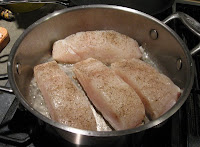
Our neighbor Jim Dixon, writer, olive oil and salt importer and, now, yurt pioneer, just got a great write-up in MIX magazine. Jim sent the following to his customers and gave GSNW permission to reprint it. Happy Thanksgiving!
Turkey Confit
I based this on a recipe from Saveur. It called for using the legs and wings from a whole turkey you’d cut up as an alternative to roasting intact. The breast was boned, pounded thin, stuffed with the same kind of dressing you usually make at Thanksgiving, rolled, tied, and roasted. Sounds okay, but too much work for the most boring part of the bird. I just bought some turkey thighs at New Seasons (one of the best deals in the meat case, but call ahead to make sure they have some). The ones I got were huge, from 25 lb. birds, and weighed about 2 pounds each. I also bought duck fat at New Seasons but, again, call first because they don’t always have it in stock. I’ve also seen recipes that use olive oil, and if you go that route you can save and reuse the oil for cooking.
I gave the thighs a good dusting of sea salt and freshly ground pepper on both sides. The Saveur recipe called for sage, thyme and ground bay leaf, but I wanted a more straightforward flavor. I left them in a baking pan in a single layer in the refrigerator overnight, uncovered.
I melted 3 lbs. of duck fat on the stove (it comes in one pound tubs, which are probably a little less than a quart), then carefully poured it over the thighs. They weren’t totally covered, but nearly. The pan, tightly covered with foil, went into a 300° oven for about 3.5 hours.
I let them cool a bit, then transferred the thighs to Cambros (the plastic containers used in food service...Cambro is the brand name, and that’s what everybody calls them...you can buy smallish versions at restaurant supply stores such as Boxer NW [438 NW Broadway - KAB]). I poured in some of the duck fat, then used another container to save the rest. The fat and juices will separate as it cools, and I’ll save the fat to use again (everything cooked in duck fat is delicious).
We’ll crisp the thighs in the fat in hot skillet up at the yurt on Thanksgiving, but I did sneak a small bite as I was putting them away. Delicious!
Photo from MIX magazine.
























































